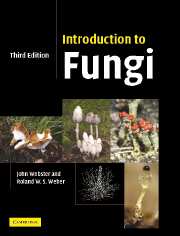Book contents
- Frontmatter
- Contents
- Preface to the first edition
- Preface to the second edition
- Preface to the third edition
- Acknowledgements
- 1 Introduction
- 2 Protozoa: Myxomycota (slime moulds)
- 3 Protozoa: Plasmodiophoromycota
- 4 Straminipila: minor fungal phyla
- 5 Straminipila: Oomycota
- 6 Chytridiomycota
- 7 Zygomycota
- 8 Ascomycota (ascomycetes)
- 9 Archiascomycetes
- 10 Hemiascomycetes
- 11 Plectomycetes
- 12 Hymenoascomycetes: Pyrenomycetes
- 13 Hymenoascomycetes: Erysiphales
- 14 Hymenoascomycetes: Pezizales (operculate discomycetes)
- 15 Hymenoascomycetes: Helotiales (inoperculate discomycetes)
- 16 Lichenized fungi (chiefly Hymenoascomycetes: Lecanorales)
- 17 Loculoascomycetes
- 18 Basidiomycota
- 19 Homobasidiomycetes
- 20 Homobasidiomycetes: gasteromycetes
- 21 Heterobasidiomycetes
- 22 Urediniomycetes: Uredinales (rust fungi)
- 23 Ustilaginomycetes: smut fungi and their allies
- 24 Basidiomycete yeasts
- 25 Anamorphic fungi (nematophagous and aquatic forms)
- References
- Index
- Plate section
13 - Hymenoascomycetes: Erysiphales
- Frontmatter
- Contents
- Preface to the first edition
- Preface to the second edition
- Preface to the third edition
- Acknowledgements
- 1 Introduction
- 2 Protozoa: Myxomycota (slime moulds)
- 3 Protozoa: Plasmodiophoromycota
- 4 Straminipila: minor fungal phyla
- 5 Straminipila: Oomycota
- 6 Chytridiomycota
- 7 Zygomycota
- 8 Ascomycota (ascomycetes)
- 9 Archiascomycetes
- 10 Hemiascomycetes
- 11 Plectomycetes
- 12 Hymenoascomycetes: Pyrenomycetes
- 13 Hymenoascomycetes: Erysiphales
- 14 Hymenoascomycetes: Pezizales (operculate discomycetes)
- 15 Hymenoascomycetes: Helotiales (inoperculate discomycetes)
- 16 Lichenized fungi (chiefly Hymenoascomycetes: Lecanorales)
- 17 Loculoascomycetes
- 18 Basidiomycota
- 19 Homobasidiomycetes
- 20 Homobasidiomycetes: gasteromycetes
- 21 Heterobasidiomycetes
- 22 Urediniomycetes: Uredinales (rust fungi)
- 23 Ustilaginomycetes: smut fungi and their allies
- 24 Basidiomycete yeasts
- 25 Anamorphic fungi (nematophagous and aquatic forms)
- References
- Index
- Plate section
Summary
Introduction
The Erysiphales are a clearly defined, monophyletic order of about 500 species, all of which are obligately biotrophic pathogens of plants. Braun (1987, 1995) has provided thorough monographic treatments of this group, including descriptions of most known species. There is only one family, the Erysiphaceae. The species grouped here cause symptoms readily recognized as ‘powdery mildews’ because the conidia produced in abundance on the shoots of infected host plants give them a whitish powdery appearance. The term ‘powdery mildews’ is often also applied to the organisms causing them. Only angiosperms are attacked, almost always belonging to the dicotyledons. One notable exception is the powdery mildew of cereals and grasses caused by Blumeria graminis (formerly Erysiphe graminis). Other economically relevant species are Podosphaera leucotricha causing apple mildew, Podosphaera (formerly Sphaerotheca) mors-uvae causing American gooseberry mildew, and Uncinula necator (now Erysiphe necator) causing the powdery mildew of grapes. Many other species produce less destructive infections and are ubiquitous in nature, e.g. Microsphaera alphitoides (now Erysiphe alphitoides) on the leaves of oak (Quercus spp.) and Phyllactinia guttata on hazel and many other broad-leaved trees. Being obligate biotrophs, powdery mildews cannot be kept in axenic culture, although Arabi and Jawhar (2002) have recently grown B. graminis on agar augmented with shredded barley leaves. The possibility of infecting Arabidopsis thaliana with several different powdery mildew species holds promise for future investigations (Vogel & Somerville, 2002).
- Type
- Chapter
- Information
- Introduction to Fungi , pp. 390 - 413Publisher: Cambridge University PressPrint publication year: 2007



